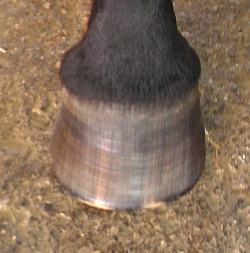Extreme weather like we have been seeing this summer can affect the horse’s hooves mightily. Obviously, the most affected horses are those who are out in it more.
This time of year, that would be yearlings, mares, and foals. Racehorses are largely unaffected because their routine keeps them away from the element of weather much of the day.
Severe drought and hot dry summer days can affect horses’ feet enough to rethink your hoof care strategy. Hooves will become very dry, very hard, and actually contract slightly. This does not happen quickly but if you’ve been in a drought for several weeks, it becomes quite noticeable.
Another effect extreme weather can have is to retard hoof growth. The two pictures are of the same Thoroughbred mare four weeks after her last trim. Those feet look like four days since her last trim. Keep in mind that Thoroughbreds are generally higher-maintenance when it comes to hoof care.
Knowing how weather can change hooves, it is beneficial to get the horses trimmed before they reach extreme stages, and then leave them alone until weather moderates. Foals should still be looked at in regular intervals to judge the conformation and growth progress of each horse even if you’ve already decided not to trim them. Corrections that the farrier trims into a foal’s hoof will hold longer during drought conditions.
Development of the joints in the lower limb still needs to be monitored closely. Fetlock joints mature in about 90 days. If your foal is still in that window, keep checking its conformation with a farrier, vet, or anyone with an experienced eye, even if it doesn’t necessarily need to be trimmed.
Yearlings are in the stage where we look at knees closely. Lower limb rotation can still occur in yearlings, but the fetlock joint will not angulate in or out. As with foals, the farrier’s correction will hold for a longer time on yearlings during very dry conditions.
If mares were well-maintained before the onset of drought conditions, they will probably need little maintenance until the ground gets some moisture. Some mares actually do better when hooves become extremely hard. If your mares are in need of a trim during drought, you will need to allow for extra time to trim them because of the extreme hardness of the hooves.
 This Thoroughbred mare has not had a hoof trim in four weeks, but dry conditions retarded her hoof growth so much that a new trim was unneeded.
This Thoroughbred mare has not had a hoof trim in four weeks, but dry conditions retarded her hoof growth so much that a new trim was unneeded.
Weather conditions don’t normally affect racehorses because they are kept in a controlled environment much of the time. However, if your racehorse is in a paddock a lot of hours, it may be necessary to pack the feet with mud more often. When hooves reach extremely dry and contracted conditions, they don’t function as well. When the hoof hits the racetrack, it expands and contracts as the pressure of landing is exerted on it. This helps dissipate the shock from landing. To stop or compromise this hoof expansion could have ill effects on the hoof or possibly even the lower limb structures of the leg because of the reduced shock absorption from the hoof.
While it is true, among racehorses, those hooves that are too soft have more problems than ones that are too hard. The situation of extreme hardness and moisture loss trumps that normal standard. Again, the horses most affected by drought conditions are those at the farms. These horses are not subjected to the potential injuries of racing and training due to hard feet, but still need altered hoof care strategies in severe conditions.
Obviously, it is not practical to pack feet on horses that are in a field, but you can do other things such as wet the ground where they feed and drink. If hooves are like concrete there is no reason to beat your head against the wall and try to trim them because the calendar says they are due. Make sure the older horses aren’t broken up, check conformation of the young horses and make certain the racehorses stay clear of extreme dryness in their feet.
Horses’ hooves change with the environment. Just because those hooves turn into rocks doesn’t mean your hoof care schedule should be set in stone.
Veteran Standardbred farrier Steve Stanley of Lexington, Ky., authors a monthly column for Hoof Beats, the official harness racing publication of the U.S. Trotting Association. The American Farriers Journal Editorial Advisory Board member offers plenty of practical advice that will be of special interest regardless of the type of horses that you work with. Click here to read more from Steve Stanley's Hoof Beats series.








Post a comment
Report Abusive Comment